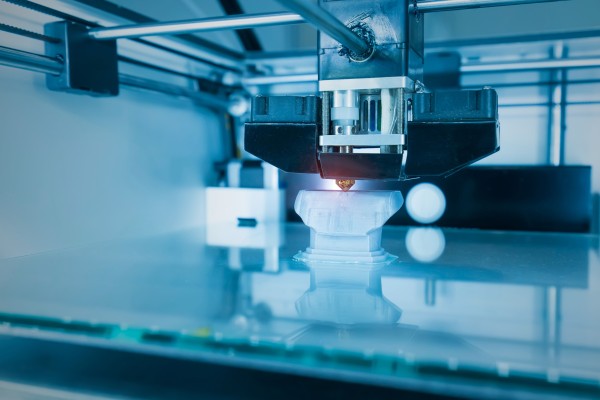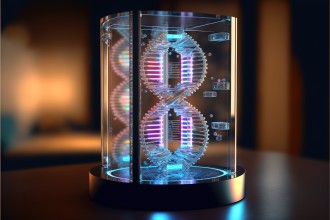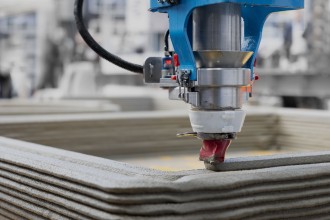What drives us to talk about 3D technologies? ensun aims to speed up global business progress. Our web crawlers gather data, and our text-based algorithms organize it systematically. By combining our internal data with external sources, we offer insights into the latest technologies and spotlight the top innovators behind them.
For this report, we've analyzed over 2000+ relevant 3D technology companies.
Firstly, we must define what 3D technologies are. Typeset defines them as “the use of three-dimensional imaging, printing, and integration techniques in various fields. It enables the creation of complex objects and components based on computer models, layer by layer, resulting in stereoscopic objects.”
With this in mind, let’s dive into forecasted developments for 3D technologies.
Forecasted Developments for 3D Technologies
According to Statista, the global 3D printing market was valued at around $12.6 billion in 2020 and is expected to grow at a significant rate, reaching an estimated compound annual growth rate of 17% between 2020 and 2023. This rapid growth is fueled by the technology's ability to create a wide range of products and applications, with new materials and uses constantly emerging.
This growth in 3D printing is directly linked to the increasing demand for customization. A Deloitte study found that more than half of consumers are interested in purchasing customized products or services, and are even willing to pay more for them. Furthermore, McKinsey reports that companies excelling at personalization generate 40% more revenue than those that don't. This trend highlights the growing consumer desire for unique and personalized items.
Statistically, the desire for customization aligns perfectly with the evolving capabilities of 3D printing. Another survey on Statista showed that in 2015 and again in 2020, European businesses ranked “accelerating product development” and “offering customized products and limited series” as their top priorities for using 3D printing. This data suggests that 3D printing is perfectly positioned to meet the growing demand for personalization.
In essence, the surging 3D printing market promises a future full off possibility. As technological advancements make 3D printing more accessible and efficient, we can expect a significant impact across various aspects of our lives. From personalized items seamlessly integrating into our daily routines, to businesses streamlining their operations with faster prototyping and on-demand parts. The potential for transformation is undeniable. Economically, the landscape could also undergo a shift, with localized manufacturing potentially becoming more prominent and fostering more sustainable practices. The true extent of 3D printing's influence remains to be seen, but its role in reshaping how we interact with the world around us is a captivating prospect.
Latest 3D Technologies and their Top Innovators
Since innovation drives economic growth, let's explore some cutting-edge advancements gaining traction within industries but not yet widely recognized by the public. We'll delve into these exciting trends and highlight the leading companies at the forefront of each technological wave.
So, let's take a closer look at very promising technological trends.
3D Data Capturing
3D data capturing is the process of taking real-world objects and environments and turning them into digital 3D models. This is achieved through various technologies like laser scanners and specialized cameras that gather precise information about an object's shape and, sometimes, even its color. While the technology requires specific equipment and expertise, the benefits are numerous. 3D models allow for precise measurements, virtual simulations, and the creation of detailed replicas, all without physically altering the original object.
The applications of 3D data capturing are vast. Imagine historical artifacts being meticulously preserved digitally, or intricate car parts being perfectly replicated for repair or design purposes. 3D models are revolutionizing fields like architecture, medicine, and entertainment, offering unparalleled accuracy and versatility in representing the physical world in the digital realm.
Top Innovators
- BTS Bioengineering specializes in motion capture systems, providing advanced technology to bridge healthcare and sports for precise human movement analysis.
- Noitom redefines motion capture with innovative sensor technology, making high-quality motion capture accessible and versatile for a range of applications, from education to industry.
- Mimic Productions excels in photoreal digital humans and avatar services, using advanced technology and a custom 4D capture system to deliver high-quality 3D animation and effects.
3D Mapping
3D mapping takes us beyond the flat, two-dimensional world of traditional maps. It utilizes technology to create digital representations of an area, capturing its depth and elevation. This allows for a more immersive and realistic understanding of landscapes, buildings, and even entire cities. Imagine soaring over a virtual terrain, visualizing the intricate details of a historical monument, or planning construction projects with precise measurements.
While 3D maps can be more complex to create compared to their 2D counterparts, the benefits are undeniable. They provide an intuitive way to navigate and analyze spatial data, enhancing decision-making and planning across various fields. From architects visualizing building designs to city planners optimizing traffic flow, 3D mapping is revolutionizing the way we interact with and understand our surroundings.
Top Innovators
- GeoSLAM is a top innovator because their technology allows users to easily capture and process geospatial data from challenging environments.
- vGIS stands out with cm-accurate augmented reality for BIM and GIS, allowing seamless integration of 3D scans into construction sites.
- Wingtra, a leading VTOL drone producer, offers fast and accurate surveying with 1 cm absolute accuracy, benefiting mapping, survey, and mining professionals.
Motion Capture
Motion capture, a technology used to record and translate human movement into digital data, breathes life into animation. Imagine a dancer's graceful pirouette or a martial artist's lightning-fast kicks meticulously recorded, frame by frame. This data can then be applied to create incredibly realistic animations in movies, video games, and even virtual reality experiences. While the process can be time-consuming and require specialized equipment, the results are often seamless and breathtakingly lifelike.
Motion capture isn't just about entertainment; its applications extend far beyond the realm of pixels. It plays a crucial role in fields like medicine, where it helps analyze human gait and movement patterns for rehabilitation purposes. Additionally, it's used in sports science to optimize athletic performance and prevent injuries. From captivating audiences with fantastical creatures on screen to aiding medical professionals in understanding human movement, motion capture continues to prove its versatility and importance.
Top Innovators
- BTS Bioengineering specializes in motion capture systems, providing advanced technology to bridge healthcare and sports for precise human movement analysis.
- Noitom redefines motion capture with innovative sensor technology, making high-quality motion capture accessible and versatile for a range of applications, from education to industry.
- Mimic Productions excels in photoreal digital humans and avatar services, using advanced technology and a custom 4D capture system to deliver high-quality 3D animation and effects.
Topography
Topography technologies encompass a range of tools and methods used to map and analyze the Earth's surface, from towering mountains to the depths of the ocean. These technologies, including LiDAR (Light Detection and Ranging) and photogrammetry, utilize lasers, light, and advanced algorithms to create detailed 3D models of landscapes. While traditional surveying methods require significant time and resources, topography technologies offer a faster, more precise alternative.
This newfound precision translates into numerous benefits across various fields. From guiding infrastructure development and disaster response efforts to optimizing agricultural practices and archaeological discoveries, these technologies provide invaluable data that shapes our understanding and interaction with the world around us. For instance, LiDAR can be used to map floodplains, allowing communities to better prepare for potential flooding events. The applications of topography technologies are vast and ever-evolving, constantly pushing the boundaries of what we know and how we utilize the Earth's diverse landscapes.
Top Innovators
- Optopol Technology is a leader in automated perimetry and spectral domain OCT, with 30 years of innovation and thousands of devices used worldwide.
- 3D at Depth is a leader in deep-water LiDAR technology, offering end-to-end contactless solutions for precise 3D underwater mapping and inspection at challenging depths.
- NenoVision is an innovator in correlative microscopy, producing the unique AFM-in-SEM LiteScope, which integrates atomic force microscopy with scanning electron microscopes for advanced scientific research.
Navigating Technological Evolution
3D technologies continue to revolutionize industries, fostering innovation and customization. From data capturing to topography, new tools are enhancing business efficiency and reshaping daily life. As these technologies mature, they offer a glimpse into a future where digital and physical realms converge, opening pathways for economic growth and sustainable practices.
But this is not the only field evolving technologically. Our B2B search engine unveils you suppliers for the exact technology you are looking for – globally and inter-industrial.
Start searching here now.
FAQ about 3D Technologies
3D printing is constantly evolving, but some recent advancements are impressive: high-resolution SLA offers amazing detail, metal printing lets you create strong parts in-house, multi-material machines expand design possibilities, and even 4D printing allows objects to change shape based on external triggers.
Manufacturing has been most transformed by 3D modeling. It speeds up prototyping, leads to more precise designs, and seamlessly connects with production processes thanks to Computer-Aided Manufacturing (CAM). This has revolutionized how products are designed, built, and brought to market.
3D models shine in visualization and communication, offering realistic views and easy modifications. They save time and resources compared to physical prototypes, and even allow virtual simulations for testing before production. Additionally, they integrate seamlessly with manufacturing processes.
However, creating high-quality models requires specialized skills and software. Complex models can be large files, demanding powerful computers. While visually accurate, they may not fully capture real-world textures, and can be misinterpreted without proper context. Security concerns also exist regarding unauthorized access and copyright infringement.
3D Printing: This allows students to physically create objects based on their designs, fostering hands-on learning and visualization of concepts.
3D Modeling Software: Students can learn to design and manipulate 3D objects in virtual space, developing spatial reasoning and design skills.
Virtual Reality (VR): VR headsets immerse students in interactive simulations, enabling virtual field trips, historical reenactments, and safe scientific experiments.
Augmented Reality (AR): AR overlays digital information onto the real world, providing interactive visualizations of concepts like anatomy, historical events, or scientific phenomena.
Quickscout
Auf der Suche nach
passenden Lieferanten?
Beginne jetzt mit unserer KI-basierten Lieferantensuche!





